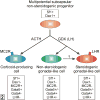Review paper: origin and molecular pathology of adrenocortical neoplasms
- PMID: 19261630
- PMCID: PMC2811968
- DOI: 10.1354/vp.46-2-194
Review paper: origin and molecular pathology of adrenocortical neoplasms
Abstract
Neoplastic adrenocortical lesions are common in humans and several species of domestic animals. Although there are unanswered questions about the origin and evolution of adrenocortical neoplasms, analysis of human tumor specimens and animal models indicates that adrenocortical tumorigenesis involves both genetic and epigenetic alterations. Chromosomal changes accumulate during tumor progression, and aberrant telomere function is one of the key mechanisms underlying chromosome instability during this process. Epigenetic changes serve to expand the size of the uncommitted adrenal progenitor population, modulate their phenotypic plasticity (i.e., responsiveness to extracellular signals), and increase the likelihood of subsequent genetic alterations. Analyses of heritable and spontaneous types of human adrenocortical tumors documented alterations in either cell surface receptors or their downstream effectors that impact neoplastic transformation. Many of the mutations associated with benign human adrenocortical tumors result in dysregulated cyclic adenosine monophosphate signaling, whereas key factors and/or signaling pathways associated with adrenocortical carcinomas include dysregulated expression of the IGF2 gene cluster, activation of the Wnt/beta-catenin pathway, and inactivation of the p53 tumor suppressor. A better understanding of the factors and signaling pathways involved in adrenal tumorigenesis is necessary to develop targeted pharmacologic and genetic therapies.
Figures


Similar articles
-
Adrenocortical stem and progenitor cells: implications for adrenocortical carcinoma.Mol Cell Endocrinol. 2012 Mar 31;351(1):2-11. doi: 10.1016/j.mce.2011.12.006. Epub 2012 Jan 13. Mol Cell Endocrinol. 2012. PMID: 22266195 Free PMC article. Review.
-
Genetics of Adrenocortical Development and Tumors.Endocrinol Metab Clin North Am. 2017 Jun;46(2):419-433. doi: 10.1016/j.ecl.2017.01.007. Epub 2017 Feb 22. Endocrinol Metab Clin North Am. 2017. PMID: 28476230 Free PMC article. Review.
-
Progression to adrenocortical tumorigenesis in mice and humans through insulin-like growth factor 2 and β-catenin.Am J Pathol. 2012 Sep;181(3):1017-33. doi: 10.1016/j.ajpath.2012.05.026. Epub 2012 Jul 15. Am J Pathol. 2012. PMID: 22800756 Free PMC article.
-
Animal models of adrenocortical tumorigenesis.Mol Cell Endocrinol. 2012 Mar 31;351(1):78-86. doi: 10.1016/j.mce.2011.09.045. Epub 2011 Nov 11. Mol Cell Endocrinol. 2012. PMID: 22100615 Free PMC article.
-
Wnt/beta-catenin and 3',5'-cyclic adenosine 5'-monophosphate/protein kinase A signaling pathways alterations and somatic beta-catenin gene mutations in the progression of adrenocortical tumors.J Clin Endocrinol Metab. 2008 Oct;93(10):4135-40. doi: 10.1210/jc.2008-0631. Epub 2008 Jul 22. J Clin Endocrinol Metab. 2008. PMID: 18647815
Cited by
-
Genomic Landscape of Pheochromocytoma and Paraganglioma.Trends Cancer. 2018 Jan;4(1):6-9. doi: 10.1016/j.trecan.2017.11.001. Epub 2017 Nov 26. Trends Cancer. 2018. PMID: 29413423 Free PMC article. Review.
-
DNA methylation profiling identifies global methylation differences and markers of adrenocortical tumors.J Clin Endocrinol Metab. 2012 Jun;97(6):E1004-13. doi: 10.1210/jc.2011-3298. Epub 2012 Apr 3. J Clin Endocrinol Metab. 2012. PMID: 22472567 Free PMC article.
-
Conditional mutagenesis of Gata6 in SF1-positive cells causes gonadal-like differentiation in the adrenal cortex of mice.Endocrinology. 2013 May;154(5):1754-67. doi: 10.1210/en.2012-1892. Epub 2013 Mar 7. Endocrinology. 2013. PMID: 23471215 Free PMC article.
-
Laser capture microdissection-reduced representation bisulfite sequencing (LCM-RRBS) maps changes in DNA methylation associated with gonadectomy-induced adrenocortical neoplasia in the mouse.Nucleic Acids Res. 2013 Jun;41(11):e116. doi: 10.1093/nar/gkt230. Epub 2013 Apr 15. Nucleic Acids Res. 2013. PMID: 23589626 Free PMC article.
-
Novel markers of gonadectomy-induced adrenocortical neoplasia in the mouse and ferret.Mol Cell Endocrinol. 2015 Jan 5;399:122-30. doi: 10.1016/j.mce.2014.09.029. Epub 2014 Oct 5. Mol Cell Endocrinol. 2015. PMID: 25289806 Free PMC article.
References
-
- Achermann JC, Meeks JJ, Jameson JL. Phenotypic spectrum of mutations in DAX-1 and SF-1. Mol Cell Endocrinol. 2001;185:17–25. - PubMed
-
- Almeida MQ, Latronico AC. The molecular pathogenesis of childhood adrenocortical tumors. Horm Metab Res. 2007;39:461–466. - PubMed
-
- Altman NH, Streett CS, Terner JY. Castration and its relationship to tumors of the adrenal gland in the goat. Am J Vet Res. 1969;30:583–589. - PubMed
-
- Artandi SE, Attardi LD. Pathways connecting telomeres and p53 in senescence, apoptosis, and cancer. Biochem Biophys Res Commun. 2005;331:881–890. - PubMed
-
- Auchus RJ. Overview of dehydroepiandrosterone biosynthesis. Semin Reprod Med. 2004;22:281–288. - PubMed
Publication types
MeSH terms
Grants and funding
LinkOut - more resources
Full Text Sources
Research Materials
Miscellaneous

